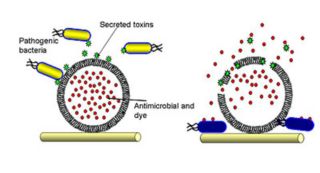Revolutionary medical dressing uses nano-technology to fight infection
Researchers are using nanotechnology to develop a medical dressing which will detect and treat infection in wounds.
Scientists at the University of Bath and the burns team at the Southwest UK Paediatric Burns Centre at Frenchay Hospital in Bristol are working together with teams across Europe and Australia to create an advanced wound dressing.
The dressing will work by releasing antibiotics from nanocapsules triggered by the presence of disease-causing pathogenic bacteria, which will target treatment before the infection takes hold.
The dressing will also change colour when the antibiotic is released, alerting healthcare professionals that there is infection in the wound.
This is an important step in treating burns patients, particularly children, where infections can lead to toxic shock syndrome, a potentially fatal condition.
The €4.5 million European Commission funded project is a collaboration of 11 partners across Europe and Australia coordinated by Dr Renate Förch, at the Max-Planck-Institute for Polymer Research (Germany), which will develop the prototype dressing over four years.
 The dressing will be coated with nanocapsules that contain antibiotics and a dye (shown in red) that are broken open by toxins (green) produced by disease-causing bacteria (yellow)
The dressing will be coated with nanocapsules that contain antibiotics and a dye (shown in red) that are broken open by toxins (green) produced by disease-causing bacteria (yellow)
The Bacteriosafe project includes chemists, cell biologists, clinicians and engineers. They will not only develop the dressing, but will also work with industry on a pre-pilot scale manufacturing process, so they could be available on the market within a few years after completion of the project.
University of Bath project leader, Dr Toby Jenkins said: “Your skin is normally home to billions of ‘friendly’ bacteria, which it needs to stay healthy.
“The dressing is only triggered by disease-causing bacteria, which produce toxins that break open capsules containing the antibiotics and dye.
“This means that antibiotics are only released when needed, which reduces the risk of the evolution of new antibiotic-resistant super-bugs such as MRSA.”
Dr Amber Young, a paediatric burn specialist at the South West UK Paediatric Burn Centre, based at Bristol’s Frenchay Hospital, will be the clinical consultant on the project.
She said: “We’re really excited about this project – every day we see young children who are seriously ill from burns who would hugely benefit from this research.
“Many people don’t realise that a burn from a cup of tea can be deadly if it becomes infected.
“Conventional dressings have to be removed if the skin becomes infected, which slows healing and can be distressing for the child.
“This advanced dressing will speed up treatment because it is automatically triggered to release antibiotics only when the wound becomes infected, meaning that the dressing will not need to be removed, thereby increasing the chances of the wound healing without scarring.
“The colour change acts as an early warning system that infection is present, meaning we can treat it much faster, reducing the trauma to the child and cutting the time they have to spend in hospital.”
The dressing could also be used for other types of wound, such as ulcers or by the military on the battlefield.
The researchers have already tested fabric coated with the nanocapsules, which are just one millionth of a millimetre in size. They have been shown to react specifically to harmful bacteria. Over the next four years the European team will be working on integrating the colour change technology into a suitable dressing and looking at cost effective routes for industrial production.
Case study – Baby Isambard Ebbutt
In September 2008 baby Isambard Ebbutt pulled a boiling hot cup of tea over himself causing 32 per cent burns across his face and body.
Isambard, who was just 13-months-old, was rushed to Frenchay Hospital in Bristol where he was treated by a team of experts at the South West Regional Paediatric Burns Service.
Luckily Isambard’s skin healed fully and he did not need skin grafts. His family took Isambard home to Ellacombe, in Torquay, Devon, ten days after he was admitted.
Natalie Ebbutt, a mum of six, said: “I thought he was going to die, I just wanted my baby to live so I wanted him to be in the best place.
“It is so poignant that a cup of tea can kill, but I don’t think that parents are aware of the damage that a cup of tea can do. I see adults walking around all the time with hot drinks near children.”
Although Isambard recovered well from his burn, many children can develop potentially fatal infections after they are injured. The new dressing to be developed by the Bacteriosafe team will help prevent and treat infections before they take hold.
Mrs Ebbutt said: “I knew that the biggest chance of losing my child was if an infection took hold but all I could do was cross my fingers and hope for the best.
“To think now that there is a possibility of avoiding serious infection and complications with this project is amazing.”
“It’s a very exciting breakthrough, I am now all too aware of the dangers and what can happen if a burns wound gets an infection, it’s devastating.
“There is never a day that goes by when we don’t think how lucky we are to have him in such a perfect condition and see his smiling face.”
Source: University of Bath; July 8, 2010
The originator of a press release or news release is responsible for it's content, not the UnderstandingNano Web site or Hawk's Perch Technical Writing, LLC
_______________________
Advertisments
_______________________
--------------------------
---------------------------

